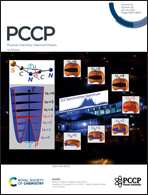How oxidized EGCG remodels α-synuclein fibrils into non-toxic aggregates: insights from computational simulations†
Abstract
The misfolding and aggregation of the presynaptic protein α-synuclein (α-syn) is a pathological hallmark of Parkinson's disease (PD). Targeting α-syn has emerged as a promising therapeutic strategy for PD. Emerging in vitro evidence supports a dual action of epigallocatechin-3-gallate (EGCG) against amyloid neurotoxicity. EGCG can halt the formation of toxic aggregates by redirecting the amyloid fibril aggregation pathway toward non-toxic aggregates and remodeling the existing toxic fibrils into non-toxic aggregates. Moreover, EGCG oxidation can enhance fibril's remodeling by forming Schiff bases, leading to crosslinking of the fibril. However, this covalent modification is not required for amyloid remodeling, and establishing non-specific hydrophobic interactions with sidechains seems to be the main driver of amyloid remodeling by EGCG. Thioflavin (ThT) is a gold standard probe to detect amyloid fibrils in vitro, and oxidized EGCG competes with ThT for amyloid fibrils’ binding sites. In this work, we performed docking and molecular dynamics (MD) simulations to gain insights into the intermolecular interactions of oxidized EGCG and ThT with a mature α-syn fibril. We find that oxidized EGCG moves within lysine-rich sites within the hydrophobic core of the α-syn fibril, forming aromatic and hydrogen-bonding (H-bond) interactions with different residues during the whole MD simulation time. In contrast, ThT, which does not remodel amyloid fibrils, was docked to the same sites but only via aromatic interactions. Our findings suggest that non-covalent interactions play a role in oxidized EGCG binding into the hydrophobic core, including H-bond and aromatic interactions with some residues in the amyloid remodeling processes. These interactions would ultimately lead to a disturbance of structural features as determinants for stabilizing this fibril into a compact and pathogenic Greek key topology.



 Please wait while we load your content...
Please wait while we load your content...